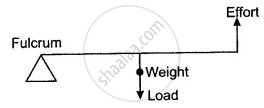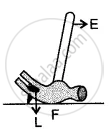Advertisements
Advertisements
प्रश्न
When we want to use a machine as a force multiplier, which class of lever should we preferably use? Give a simple diagram of such a lever.

उत्तर
Though we can use either first class of lever or second class of lever, for multiplying force, we should preferably use a second class of lever. This is because the mechanical advantage of the second class of lever is always greater than one. A simple diagram of the second class of lever is shown alongside. The wheelbarrow, the bottle opener, and the mango cutter are some of the practical forms of the second class of lever.
APPEARS IN
संबंधित प्रश्न
The lever for which the mechanical advantage is less than 1 has :
Define Lever
A lever of length 9 cm has its load arm 5 cm long and the effort arm is 9 cm long.
- To which class does it belong?
- Draw a diagram of the lever showing the position of fulcrum F and directions of both the load L and effort E.
- What is the mechanical advantage and velocity ratio if the efficiency is 100%?
- What will be the mechanical advantage and velocity ratio if the efficiency becomes 50%?
Give three examples for leavers of second order.
Give three examples for leavers of the third order.
Which class of lever found in the human body is being used by a boy when he raises the weight of his body on his toes?
The following belong to which class of lever?
Sugar tongs
The following belong to which class of lever?
A pair of scissors
The following are an example of levers. State the class of lever to which each one belongs giving the relative positions of Load (L), Effort (E), Fulcrum (F):
(i) Scissors (ii) Sugar tongs (iii) Nutcracker (iv) Pliers.
In the diagram shown alongside a claw hammer, mark the fulcrum (F) and indicate the directions of load (L) and effort (E) with arrows. What class of lever is it? Give one more example of this class of lever.

